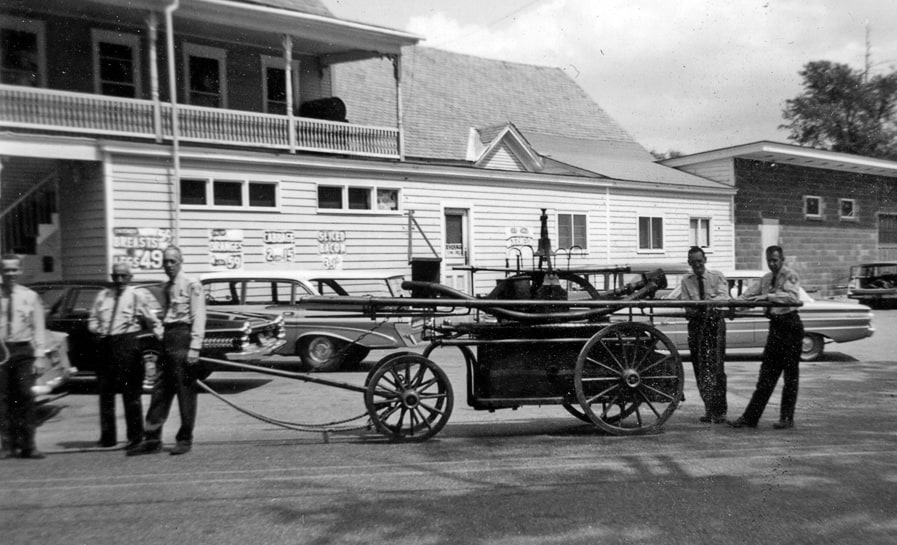
Yankee food can be rather bland for those not accustomed to it. Dried beef or salmon pea wiggle gravy probably wouldn’t excite your taste buds. This style of cooking dates back to our earliest ancestors. Drying or salting meat and fish was how we preserved food in the days before refrigeration. Generations since have lived on this diet. I grew up in such an environment.
I don’t think anyone in my family would have known what olive oil was. We used lard, bacon fat, or butter for everything. Lard makes the best pie crust and donuts. Spices we didn’t have or know much about, other than those needed to bake an apple pie.
We did have garlic salt, oregano, store bought ground black pepper, and salt on hand.
Oyster stew
Another bland meal I like is oyster stew. I have a couple 1920s menus from The Fullerton promoting oyster suppers. Ted Spaulding told me about an oyster supper at the Odd Fellows Hall in Saxtons River. Churches and fraternal organizations often had oyster suppers.
I remember my mother telling my father it was oyster season, and to pick up a pint of oysters at the store. Al’s IGA, where Blair Books is today, carried oysters, when in season, as did Jameson’s. Oysters were sold in pint and half pints.
I remember Ma telling me you could only get oysters in a month spelled with an “r.” May, June, July, and August, oysters weren’t available.
Some will remember Jameson’s store. Today it is Smitty’s. Hugh Jameson ran the store in those days. The side of the store facing Bennett’s would have signs tacked on the wall promoting what was on sale that week. These signs might have been 24 inches or more square. They were made with stencils. You watched every week for specials.
In the photo, look behind the three men on the left and you will see these signs. I see in the sign at left that chicken breasts were 49 cents per pound. The photo probably predates 1965. My mother watched for, “OYSTERS ‘R’ IN SEASON.” This is as close as we came to seafood.
I don’t remember all of, or how oyster stew was made now, so I called Ted Spaulding and Danny Clemons. It’s a very simple recipe. Melt a stick of butter in a large pot, add milk – adding a little cream doesn’t hurt –, and pepper. Add oyster liquid, simmer, and then add the oysters. Simmer until the edges of the oysters become ruffled. This is how I remember it. That’s it. If you add chunks of potato, it becomes oyster chowder.
Everyone had a different technique for eating it. I like it with oyster crackers. Drop a few in the bowl and lightly stir them. After a minute or so with my soup spoon, I would turn each cracker over. I didn’t want crunchy or soggy crackers. I like a spoonful of stew with a cracker that has absorbed some of the liquid, but is still crunchy. I always saved an oyster for the last spoonful. Everyone had their own method.
Some might have oyster stew with saltines. Either way, oyster stew makes a good supper. Danny Clemons told me how his father, Bill, liked his oyster stew. Danny couldn’t remember the name of the crackers his father liked, but they were larger. Bill would split the cracker in half with a knife and butter each half.
In our house we had corn bread with butter. Dipping the corn bread in the stew was our method. We had asparagus in our garden. If the season was right, we had asparagus on the side. And yes, more butter, with salt and pepper.
I haven’t had oyster stew in 40 years or more, but I had SOS for breakfast Sunday morning.
The photo
Danny thinks the black Dodge Dart is his father’s. Ted Spaulding thinks the men are, from left to right: “left may be Ralph Stoddard. Frank Lamothe, Gene Guy, and Arnie Stoddard. We don’t know who the other man is.”
Danny agrees with Ted, but thinks Arnie Stoddard might be Norm Heald.
This week’s old saying is from my older sister Norma. I went to see her after she had lost a big toe: “so much for flip flops,” she said.